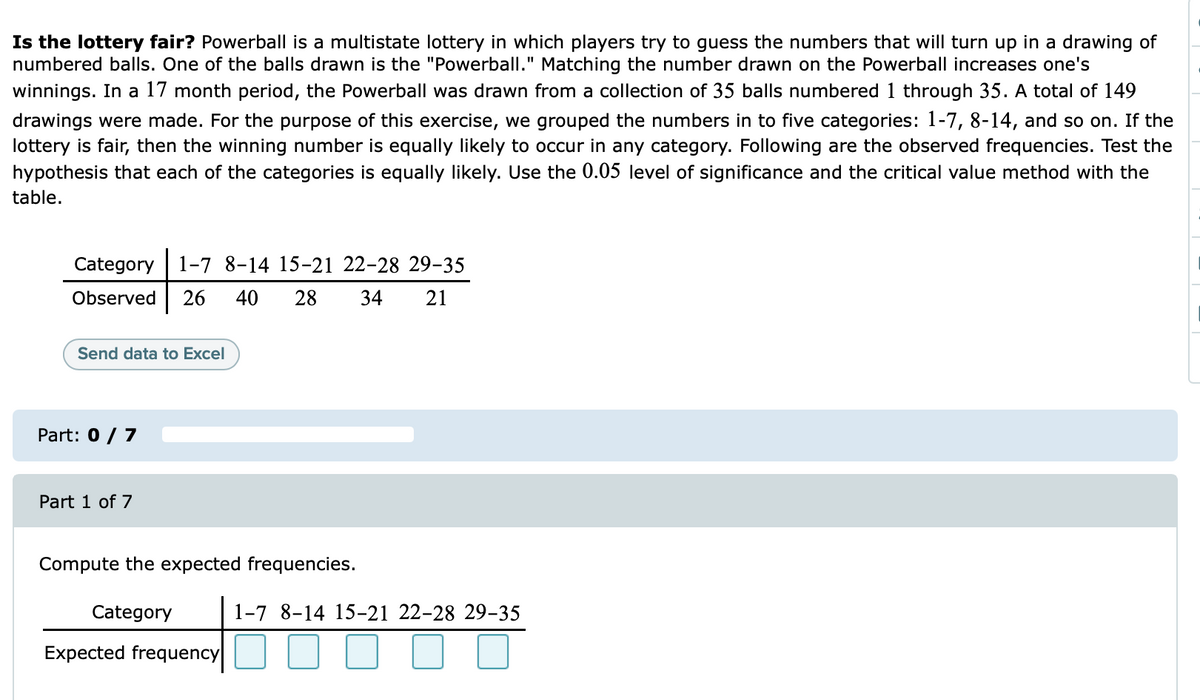Is the lottery fair? Powerball is a multistate lottery in which players try to guess the numbers that will turn up in a drawing of numbered balls. One of the balls drawn is the "Powerball." Matching the number drawn on the Powerball increases one's winnings. In a 17 month period, the Powerball was drawn from a collection of 35 balls numbered 1 through 35. A total of 149 drawings were made. For the purpose of this exercise, we grouped the numbers in to five categories: 1-7, 8-14, and so on. If the lottery is fair, then the winning number is equally likely to occur in any category. Following are the observed frequencies. Test the hypothesis that each of the categories is equally likely. Use the 0.05 level of significance and the critical value method with the table. Category 1-7 8-14 15-21 22-28 29-35 Observed 26 40 28 34 21 Send data to Excel Part: 0 / 7 Part 1 of 7 Compute the expected frequencies. Category 1-7 8-14 15-21 22-28 29-35 O O O O Expected frequency
Is the lottery fair? Powerball is a multistate lottery in which players try to guess the numbers that will turn up in a drawing of numbered balls. One of the balls drawn is the "Powerball." Matching the number drawn on the Powerball increases one's winnings. In a 17 month period, the Powerball was drawn from a collection of 35 balls numbered 1 through 35. A total of 149 drawings were made. For the purpose of this exercise, we grouped the numbers in to five categories: 1-7, 8-14, and so on. If the lottery is fair, then the winning number is equally likely to occur in any category. Following are the observed frequencies. Test the hypothesis that each of the categories is equally likely. Use the 0.05 level of significance and the critical value method with the table. Category 1-7 8-14 15-21 22-28 29-35 Observed 26 40 28 34 21 Send data to Excel Part: 0 / 7 Part 1 of 7 Compute the expected frequencies. Category 1-7 8-14 15-21 22-28 29-35 O O O O Expected frequency
Chapter8: Sequences, Series,and Probability
Section8.7: Probability
Problem 6ECP: In Pennsylvania’s Cash 5 game, a player chooses five different numbers from 1 to 43. If these five...
Related questions
Question

Transcribed Image Text:Is the lottery fair? Powerball is a multistate lottery in which players try to guess the numbers that will turn up in a drawing of
numbered balls. One of the balls drawn is the "Powerball." Matching the number drawn on the Powerball increases one's
winnings. In a 17 month period, the Powerball was drawn from a collection of 35 balls numbered 1 through 35. A total of 149
drawings were made. For the purpose of this exercise, we grouped the numbers in to five categories: 1-7, 8-14, and so on. If the
lottery is fair, then the winning number is equally likely to occur in any category. Following are the observed frequencies. Test the
hypothesis that each of the categories is equally likely. Use the 0.05 level of significance and the critical value method with the
table.
Category
1-7 8-14 15-21 22-28 29-35
Observed
26
40
28
34
21
Send data to Excel
Part: 0 / 7
Part 1 of 7
Compute the expected frequencies.
Category
1-7 8-14 15-21 22-28 29-35
Expected frequency
Expert Solution
This question has been solved!
Explore an expertly crafted, step-by-step solution for a thorough understanding of key concepts.
This is a popular solution!
Trending now
This is a popular solution!
Step by step
Solved in 2 steps with 2 images

Recommended textbooks for you


Glencoe Algebra 1, Student Edition, 9780079039897…
Algebra
ISBN:
9780079039897
Author:
Carter
Publisher:
McGraw Hill

Holt Mcdougal Larson Pre-algebra: Student Edition…
Algebra
ISBN:
9780547587776
Author:
HOLT MCDOUGAL
Publisher:
HOLT MCDOUGAL


Glencoe Algebra 1, Student Edition, 9780079039897…
Algebra
ISBN:
9780079039897
Author:
Carter
Publisher:
McGraw Hill

Holt Mcdougal Larson Pre-algebra: Student Edition…
Algebra
ISBN:
9780547587776
Author:
HOLT MCDOUGAL
Publisher:
HOLT MCDOUGAL

College Algebra (MindTap Course List)
Algebra
ISBN:
9781305652231
Author:
R. David Gustafson, Jeff Hughes
Publisher:
Cengage Learning